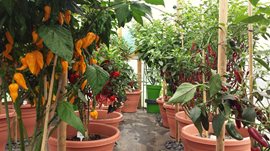For those who are green-fingered, there’s nothing better than cooking wholesome and healthy meals with vegetables and fruit that you’ve nurtured yourself. Plus, you don’t have to wait until our great British “summer” to grow them. You can extend the season to grow fruit and vegetables and enjoy home-grown, healthy food all year round. How you ask? When you find out how to use a polytunnel, you’ll wonder why you ever spent money on supermarket veg!
Here are some easy-to-grow pantry favourites that you’ll be proud to take from patch to plate:
 Growing Garlic at Home
Growing Garlic at Home
As well as having plenty of health benefits, garlic is versatile to cook with, delicious and easy to grow at home. It is a fairly low maintenance veg to add to your patch and it doesn’t take up much room. Plus, it needs a cold period to grow successfully, so you won’t have to worry about growing it outdoors in the winter. However, birds love to pull up freshly planted garlic, so a polytunnel can protect your bulbs.
Here are a few tips on how to grow the tastiest garlic bulbs at home:
- Buy garlic sets from a garden centre rather than a supermarket. You can choose from two main types: hardneck and softneck, which you can learn more about here.
- Split the bulb into individual cloves and plant each one about 2.5cm deep into the soil (with the pointed end facing up).
- Each clove should be planted 10-15cm apart in rows around 30cm apart.
Garlic bulbs grow best in light, nutrient-rich soil. Make sure you dig in plenty of compost or recycled green waste before planting them as they don’t react well to water-logging.
Growing Potatoes at Home
Another cupboard essential for most homes, growing your own potatoes could help you save money in the weekly grocery shop. Whether you’re a mash, boiled or roast potatoes family, you can enjoy an organic and home-grown feast.
Seed potatoes can be planted at almost any time of the year and they’re easy to grow, as long as they’re kept free from the frost. Plus, with the help of a polytunnel you can enjoy a very early crop – seeds planted in December or January could mean that you have early potatoes on the table as soon as March or April!
Top tip - potatoes like moist soil that is loose and free draining. Adding organic matter to the base of the trenches you plant in will help to retain soil moisture and grow the best potatoes.
 Growing Chilli at Home
Growing Chilli at Home
To add a bit of spice to your meals, chilli is the answer. Chilli plants really love the heat (the perfect temperature for them is between 27-32 °C), so it’s best to sow the seeds in the spring or to start them off indoors. When two true leaves have formed, you can continue growing them in your polytunnel, usually around late May.
It’s important to keep the humidity in the tunnel relatively high so that the soil doesn’t dry out, and organic mulches can help with this too. Keep them well-watered and, when the first fruits appear, nourish the chilli plants with a high potash organic feed.
For expert chilli growing tips, take a look at our customer Clifton Chilli Club’s easy guide. They also have great vlog updates about their ‘chilli polytunnel’ on YouTube.
If you’re wondering what to grow in a polytunnel, these three kitchen staples are a great place to start! There are no downsides to owning a polytunnel; it will protect your growing veg from pests and it can provide a warm environment for crops in the colder months. So, you can grow your own fruit and vegetables all year round without worrying about tender crops!